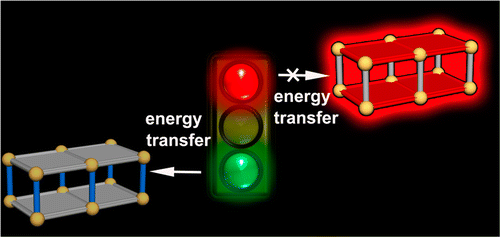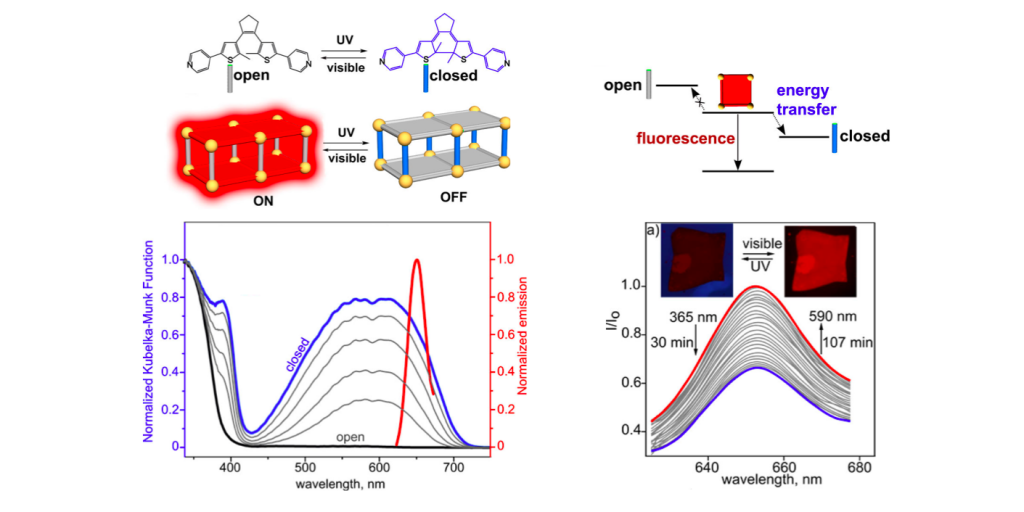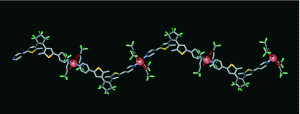D, Williams.; J, Rietman.; J, Maier.; Rui Tan.; A, Greytak.; M, Smith.; J, Krause.; N, Shustova. J. Am. Chem. Soc., 2114, ASAP
DOI: 10.1021/ja505589d
ABSTRACT: In this paper, a photochromic diarylethene- based derivative that is coordinatively immobilized within an extended porphyrin framework is shown to maintain its photoswitchable behavior and to direct the photophysical properties of the host. In particular, emission of a framework composed of bis(5-pyridyl-2-methyl-3-thienyl)- cyclopentene (BPMTC) and tetrakis(4-carboxyphenyl)- porphyrin (H4TCPP) ligands anchored by Zn2+ ions can be altered as a function of incident light. We attribute the observed cyclic fluorescence behavior of the synthesized porphyrin−BPMTC array to activation of energy transfer (ET) pathways through BPMTC photoisomerization. Time-resolved photoluminescence measurements show a decrease in average porphyrin emission lifetime upon BPMTC insertion, consistent with an ET-based mecha- nism. These studies portend the possible utilization of photochromic ligands to direct chromophore behavior in large light-harvesting ensembles.
Introduction
Because of its readiry preparation and beautiful shape of Metal-organic framework (MOF), various research has been done including architectural designs, storage capabilities, and electric conductivity. On the other hand, photochromic diarylethene (DEA), one of the most widely used photo-switch molecule, also has been extensively studied. In the paper, professor Natalia Shustova combined these two systems to achieve a fluorescence switchable MOF.
Structural design
In this report, previously reported MOF[1] and coordinatable DAE[2] are combined to successfully achieve photo-responsive light harvesting system.
Fluorescence switch
As illustrated below, Diarylethene hybrid MOF exhibited fluorescence in its initial state. Irradiation of UV light to MOF generated DAE ‘s longer region absorption that overlaps the sharp emission from MOF. Subsequently, energy transfer occurred to quench the emission. Additionally, the fluorescence intensity can get recovered by irradiation of 590 nm light to MOF, which is cause by the disappearing of closed-ring DAE.
References
Burnett, B. J.; Choe, W. CrystEngComm 2012, 14, 6129. DOI: 10.1039/C2CE25545F
We present the sequential self-assembly of isoreticular bilayer metal–organic frameworks via a pillar insertion route. We also report the construction of a 3D framework from a 2D bilayer framework in an overall three-step self-assembly.
[2]”Photochromism of Metal Complexes Composed of Diarylethene Ligands and Zn(II), Mn(II), and Cu(II) Hexafluoroacetylacetonates”
Matsuda, K.; Takayama, K.; Irie, M. Inorg. Chem. 2004, 43, 482. DOI: 10.1021/ic035020r
Metal complexes composed of bidentate 1,2-bis(2-methyl-5-(4-pyridyl)-3-thienyl)perfluorocyclopentene (1a) and monodentate 1-(2-methyl-5-phenyl-3-thienyl)-2-(2-methyl-5-(4-pyridyl)-3-thienyl)perfluorocyclopentene (2a) photochromic ligands and M(hfac)2 (M = Zn(II), Mn(II), and Cu(II)) were prepared, and their photoinduced coordination structural changes were studied. X-ray crystallographic analyses showed the formation of coordination polymers and discrete 1:2 complexes for bidentate and monodentate ligands, respectively. The complexes underwent reversible photochromic reactions by alternate irradiation with UV and visible lights in solution as well as in the single-crystalline phase. Upon photoirradiation with UV and visible light, the ESR spectra of the copper complexes of 1a reversibly changed. While the open-ring isomer gave an axial-type spectrum, the photogenerated closed-ring isomer showed a rhombic-type spectrum. This indicates that the photoisomerization induced the change in the coordination structure.
Related Books
[amazonjs asin=”1119952891″ locale=”US” title=”Metal-Organic Framework Materials (EIC Books)”][amazonjs asin=”352732870X” locale=”US” title=”Metal-Organic Frameworks: Applications from Catalysis to Gas Storage”]







